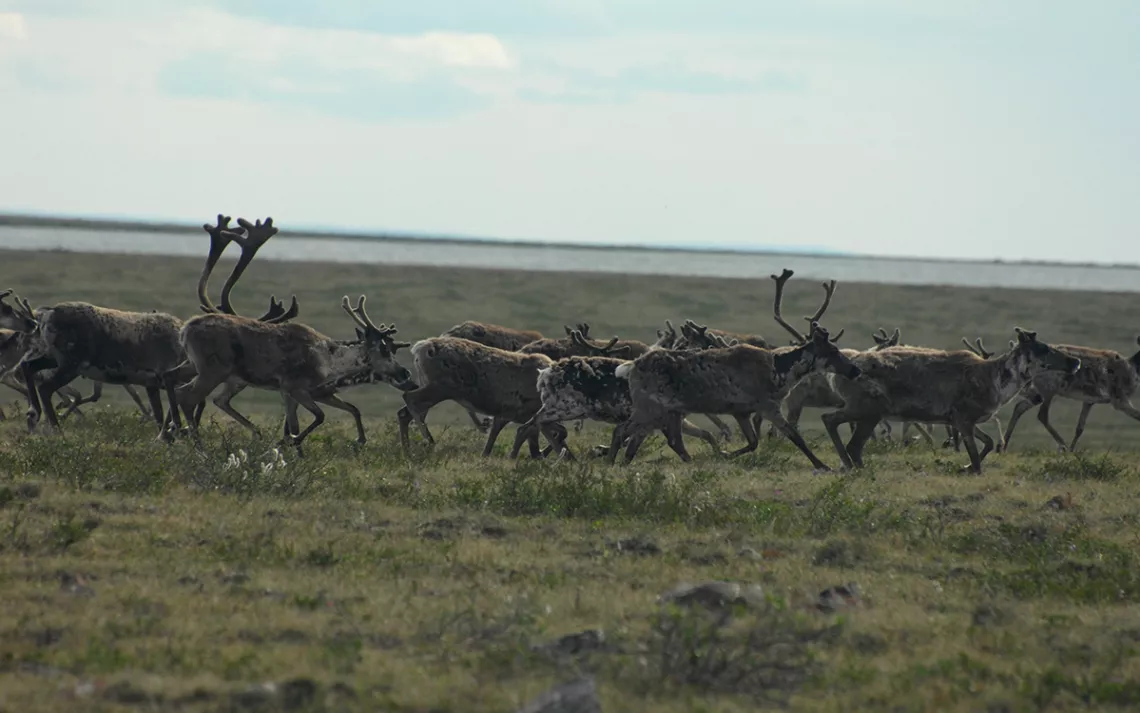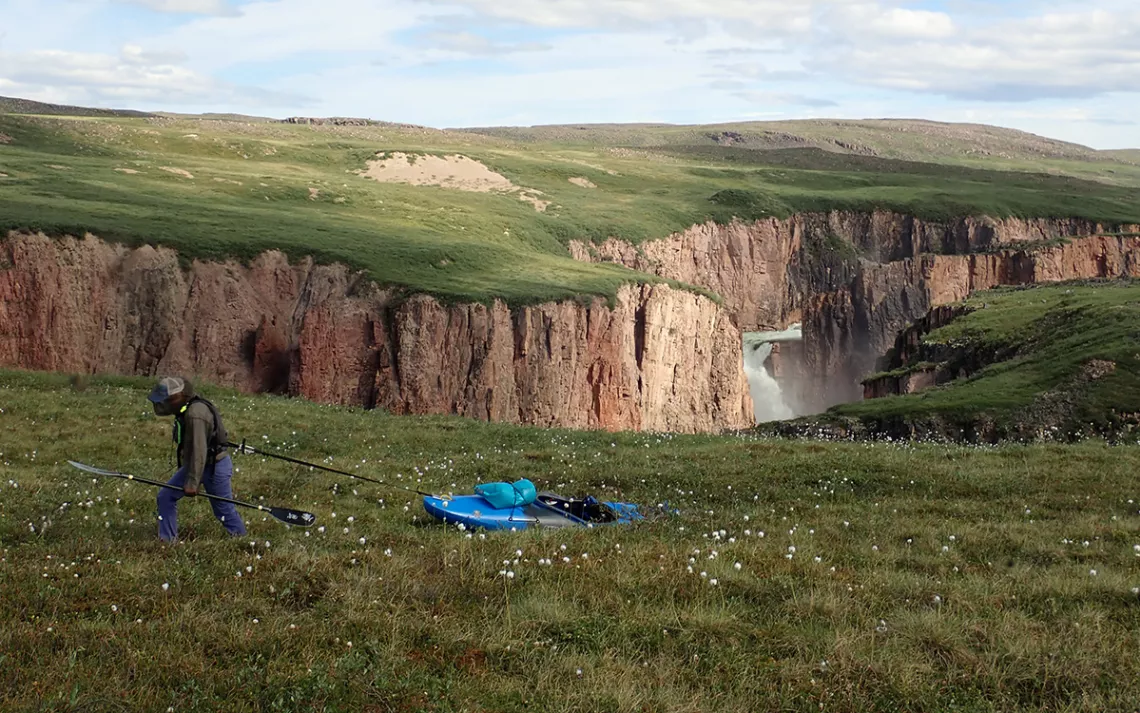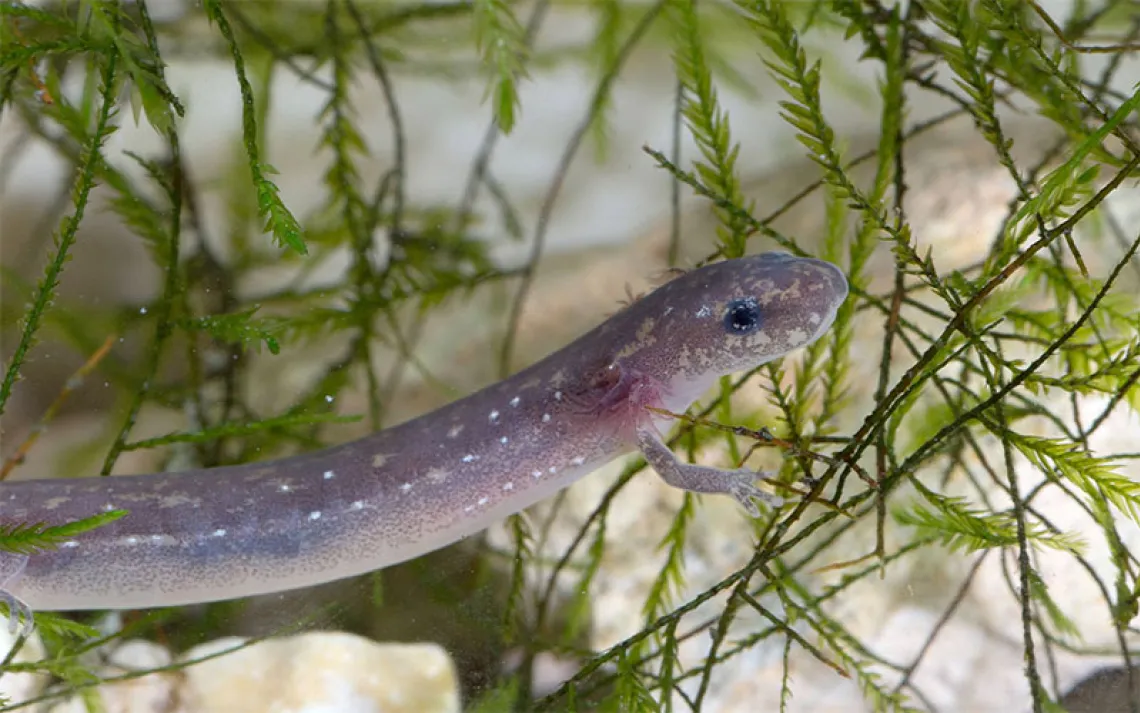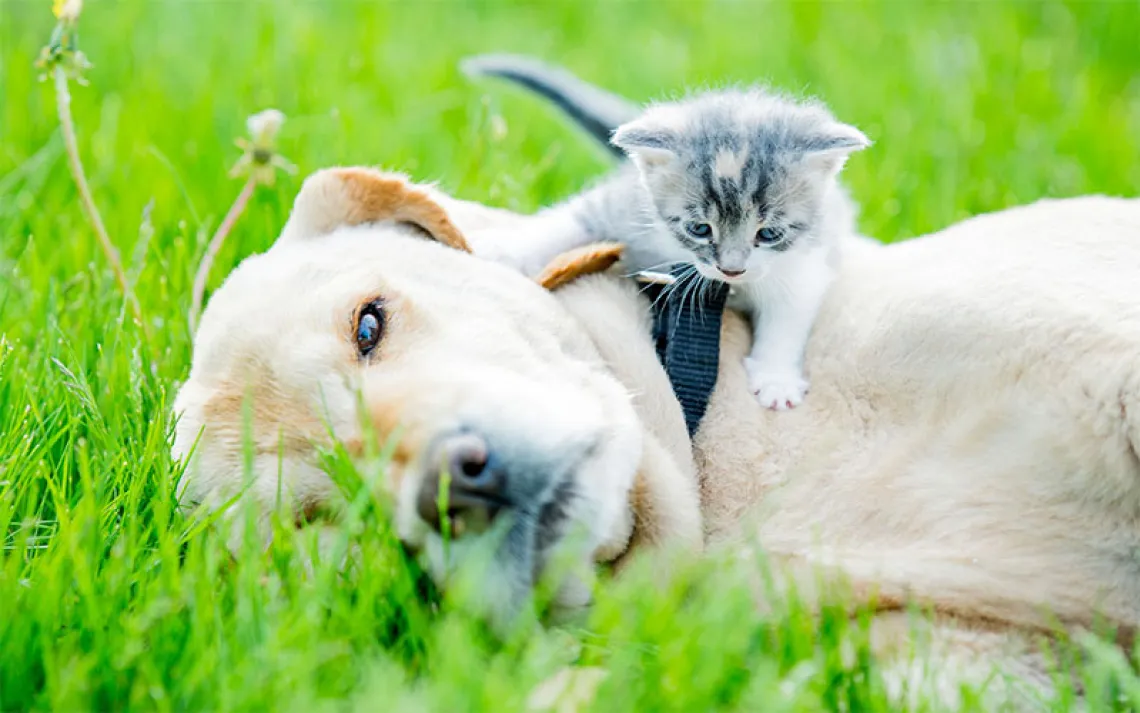Searching for the Bathurst Caribou Herd
Two kayakers, Arctic tundra, and thousands of missing caribou

Caribou herd in the Northwest Territories. | Photo courtesy of R. Decker/GNWT
In July of last year, my husband and I arrived in Yellowknife, a bustling town in Canada’s Northwest Territories. We were there to paddle the Hood River—a journey from the river’s headwaters to the Arctic Ocean. During our three weeks traveling the river and the dramatic expanse of tundra that surrounds it, we hoped to see the Bathurst caribou herd. Past accounts we had read by paddlers described seeing herds numbering in the thousands making their July migration to their calving grounds in the north.
We left Yellowknife in a de Havilland Beaver floatplane with three weeks of food, fuel, camping gear, and a pair of kayaks. We landed on Tahikafaaluk Lake, the headwaters of the Hood drainage, unloaded our gear and watched the Beaver take off just as a storm was rolling in. We spent the next two days in the tent waiting for the snowstorm to pass. On the third day, the storm finally let up and we pushed off down the lake, getting used to the balance of our heavily loaded boats.
At the drop-off site.| Photo by Erin Clancey
The first week we traversed a series of lakes interconnected by rapids and short stretches of river. The terrain was rugged and exposed, and boulder fields and granite slabs lined the lakeshore in many places. We didn’t expect to see much wildlife in this rocky landscape covered with minimal vegetation but assumed we would begin to spot signs of herds of caribou, musk ox, and the predators that follow them as we neared the coast.
On the ninth day, as we neared the end of the last lake in the Hood drainage, we noticed a change in the landscape as the sterile landscape of the rocky lakeshores began to morph into lush tundra with taller grass in marshy areas and bushes up to the knee. Here, at the end of the lake, we saw a solitary bull caribou reclined on a patch of melting ice. We pulled ashore on the beach to have a look, hoping our sighting meant that more herds lay ahead as we descended toward the ocean.
After that, we made several other wildlife sightings. On a rainy day, as we hunkered in our camp, I noticed a very strange bounding animal in the distance. It was dark and swift, and as it came close I saw that it was a wolverine, methodically hunting the marsh. As soon as it picked up our scent, it did an about-face and vanished over a bluff, its bounding gate surprisingly efficient. When we climbed hilltops and scanned the tundra with binoculars, we often located scattered herds of muskox enjoying the breeze at the higher elevations. One morning, we almost walked into a large grizzly bear lumbering over a rise straight toward us. With the wind in our faces and the noise of the river drowning out our shouts, the bear continued its daily routine of digging up Arctic ground squirrels, eventually veering away without ever noticing our presence. The one thing we never saw were herds of caribou.
After leaving the last lake behind, we began to encounter large rapids and waterfalls forcing us to portage our kayaks and gear more frequently. Within a single day, we navigated three long portages around canyons, each harboring whitewater more rugged and dramatic than the last. This wild stretch culminated in Kingaunmiut Falls, a large and stunning waterfall that lives in the shadow of the taller and more famous Wilberforce Falls, which still lay ahead several more days downriver. Scouting for a portage route, I scrambled to the edge of a cliff for a better view and was greeted by a peregrine defending its nest over a massive 85-foot, unrunnable cascade tumbling off the tundra precipice. Below Kingaunmiut Falls, we saw plenty of signs of the caribou, but none of them looked recent: bones, antlers, ancient trails through the tundra, and even old hoof prints etched into the mud. We walked along the eerie game trails made by generations of caribou, weaving our way across the tundra and boggy marshes.

Portaging Wilberforce | Photo by Erin Clancey
Below the confluence with the Wright River, we encountered a single cow caribou wandering along the river, but no evidence of a herd nearby. When we pulled onto the beach to scout a notable rapid named Caribou Crossing, we saw yet another solitary caribou meandering aimlessly on a raised bench of land above the river high-water mark where we imagined in years past there could have been an entire herd.
We arrived above Wilberforce falls on day 16, portaged our loads, and spent a day hiking in the hills. From the high points, we could see huge swaths of open tundra valleys, all excellent caribou habitat. Still no herds. On our way back to the river, we flushed a giant bull moose from an alder grove. He looked to be in fine condition, perhaps enjoying the warming winters as the southern foliage drifts northward.
Moose and deer encroaching northward are one sign that the tundra ecosystem may be changing at the expense of caribou populations. Climate change is bringing warmer temperatures and wet weather to the Arctic and changing the characteristics of the vegetation. “Shrubification,” a term describing the spread of shrubs across the Arctic, is a process that generates low-quality forage for caribou but not moose, and increases plant biomass to fuel summer forest fires. These wildfires then can cause caribou to alter their traditional migration routes and block their access to the best habitats.
Warming temperatures can change the timing of the spring green-up, which can lead to a mismatch between the caribou breeding cycle and peak food availability and are also causing insect populations to increase in abundance. Harassment from mosquitoes and bot flies can lead to less-efficient foraging and further contribute to lower body condition and fat stores needed to meet the energetic demands of lactation and winter survival. Together, these factors reduce the foraging efficiency that transfers to reduced calf and adult survival and results in caribou vanishing from the landscape.
Downstream of Wilberforce, we could feel the Arctic coast. The air felt heavy and moist, the water tasted like mud, and the riverbanks smelled like the sea. We reached Arctic Sound on Bathurst Inlet late in the afternoon on our 19th day. Mud islands spilling from the river guarded the mouth from crashing waves and the bright blue ocean. We spent the next day hiking the coast of Bathurst Inlet, overwhelmed by the beauty of the gravel beaches and the rugged, almost mountainous backdrop.
A white wolf wandered into our camp one day, and the tracks of at least one grizzly bear covered our camp and the sandy ocean beaches. But the migrating caribou herds were missing here too, leaving only bones and antlers as indicators of their former presence.

Sign up to receive Sierra News & Views
Get articles like this one sent directly to your inbox weekly.
With this action you affirm you want to receive Sierra Club communications and may vote on policy designated by the Sierra Club Board.
The next day the Beaver landed on the river and we flew back to Yellowknife. On the flight back, my husband and I tried to explain the lack of caribou we had seen. In 2014, we had canoed the Back River in the eastern Barren Lands, which flows through the ranges of the Beverly and Ahiak caribou herds. On that six week trip on the Back, we had seen zero humans and tens of thousands of caribou.

Caribou herd seen from the Back River in 2014. | Photo by Erin Clancey
Maybe, we thought, because caribou naturally undergo population cycles, this was a normal population fluctuation and we happened to experience a bad year?
But, as I discovered later, population cycles cannot completely explain the Bathurst caribou’s absence in the heart of their historic territory. Their herd’s numbers are decreasing in a way that cannot be chalked up to simple fluctuations. The Bathurst caribou are on the brink of disaster, with their population falling over 95 percent from roughly 470,000 animals in the mid-1980s to a low of just over 8,000 today.
Climate change may play a role—though it is not the only factor as it has not had the same effects on the Beverly and Ahiak herds. Hunting may also be important, particularly over-harvesting during periods of low caribou numbers. In the recent past, hunters looking for the Bathurst herd had to search on foot or with dog teams. Now, snowmobiles and winter roads built by mining operations help hunters cover more ground and find herds even when they are scarce.
Because of this, hunting of the Bathurst herd has been banned by the government of the Northwest Territories since 2010 for non-Indigenous people. Four years later, the ban was expanded to include Indigenous groups. But according to a recent paper published in Science Advances by Brenda Parlee, John Sandlos and David Natcher, hunting pressure is not the main culprit behind caribou herd declines, and Indigenous groups were using sustainable harvest practices. Instead, the paper concluded, the Bathurst caribou herd population downturn began with the mining boom of the 1990s.
The Barren Lands region of Arctic Canada is a vast expanse. It might seem like a mine or road interspersed across so much space would make little difference to wildlife. But that hasn’t been the case. The noise, habitat loss, and traffic that accompany mining have blocked the herds from the forage that they depended on and affected the caribou’s ability to migrate to their calving grounds.
The tundra region north of Yellowknife and east into Nunavut harbors gold, diamonds, zinc, copper, and more that mining companies are eager to access. Receding Arctic sea ice has inspired proposals for developing roads and ports along the northern coast of Canada, such as the Western Nunavut Grays Bay Road and Port Project that would connect the Jericho Diamond Mine to Grays Bay on the Arctic coast. The Grays Bay Project, if it was built, would transect the Hood River and the calving grounds of the Bathurst caribou herd. Plans for the Back River Project, a gold mine that would create new open pit mines and a deepwater port on Bathurst Inlet, in the heart of the caribou’s migratory route, are already underway.
On our bush flight back to Yellowknife, we flew up the Burnside drainage and over the Lupin Gold Mine on Contwoyto Lake. Although the Lupine mine was originally developed in 1982 and has been decommissioned for over a decade, the open pit mine, roads, and destruction of the surrounding area were highly visible from the air. This area, in the heart of the Bathurst Herd’s migratory route, was once teeming with caribou. A tiny island in the middle of the Burnside River just downstream of Lake Kathawachaga is called Nadlak, in Inuktitut meaning “place where the deer cross.”
The tundra truly seemed empty. Although we saw only four lonesome caribou, we did see a wide range of other wildlife including muskoxs, a wolverine, arctic foxes, numerous bird species, a very healthy tundra grizzly digging for snacks and a jolly looking white wolf cruising the mouth of the river, leaving us hopeful that these declining trends can be reversed. Already, wildlife managers, researchers, government agencies, Indigenous leaders, many nonprofits and consulting firms advocating for conservation and environmental regulations are collaborating and voicing opinions about the urgent need to take action in protecting Arctic ecological communities. The Barren Lands, where you can see for miles while the sun shines at midnight, would never be the same if the caribou no longer wandered the tundra plains.
 The Magazine of The Sierra Club
The Magazine of The Sierra Club



